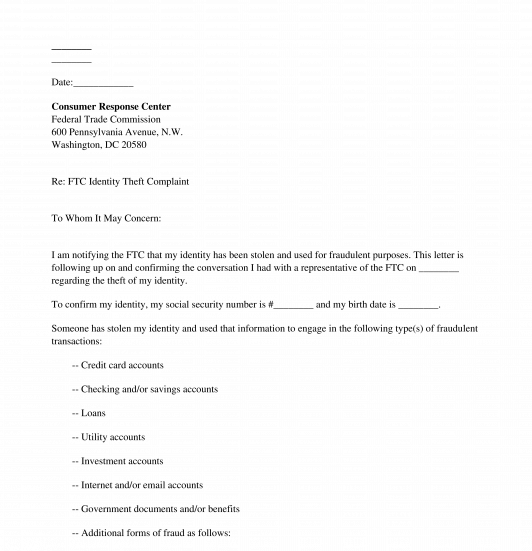 09/03/2025
09/03/2025

Answer a few questions and your document is created automatically.

Your document is ready! You will receive it in Word and PDF formats. You will be able to modify it.

 09/03/2025
09/03/2025
 Word and PDF
Word and PDF
 1 to 2 pages
1 to 2 pages



This FTC Identity Theft Complaint Letter is a document used by someone who has had their identity stolen, known as the Reporter, to alert the Federal Trade Commission (FTC) to the situation. The Reporter is able to explain the details of the situation so the FTC, which acts as a clearinghouse for reports of identity theft, can then conduct an investigation. When a person's identity has been stolen and used by the thief for tax fraud, the Reporter can also send a Notification of Fraudulent Tax Filing to the IRS so they can handle any fall out or tax consequences.
Identity theft can be an incredibly stressful situation. However, by sending an FTC Identity Theft Complaint letter, the Reporter is able to take an important first step in rectifying the situation.
How to use this document
This document contains all of the information necessary to create a thorough identity theft complaint letter to send to the FTC and assist them in any subsequent investigation. The letter first gets identifying information from the Reporter, including their name, contact information, date of birth, and social security number. The letter then goes on describe the types of fraud that have resulted from the identity theft, such as fraudulent credit cards, bank accounts, government benefits, or other sorts of fraud, as well as get a description about the particulars of the theft, including how it happened and how the Reporter became aware of the situation. The Reporter is then able to explain any harm or negative consequences they have experienced as a result of the identity theft, such as being harassed by creditors, having a civil or criminal lawsuit brought against them, or being denied employment or financial services. The Reporter is also able to give any information they may have about who they believe to be responsible for the theft if that person is known to them or they have discovered anything that would help track down that person. Finally, the letter describes what actions, if any, the Reporter has taken so far to help rectify the situation, such as contacting any of the major credit unions to put out an alert or credit freeze or contacting their local police department to begin an investigation.
Once the letter has been completed, the Reporter may print it, sign it, and send it to the Consumer Response Center at the Federal Trade Commission.
Applicable law
Issues related to identity theft and privacy are governed by both state and federal law. One of the functions of the FTC is to protect consumers by acting as a clearinghouse for reports of identity theft, gathering information and investigating, and eventually pursuing law enforcement actions. They are also instrumental in implementing policy and legislation to prevent identity theft from happening in the future. Identity theft is a criminal act that will be investigated both on the local level by police departments, but also on a state or federal level by the state Attorney General's Office, Federal Trade Commission (FTC) and the Department of Justice (DOJ). Federally, the Identity Theft and Assumption Deterrence Act is the main legislation that protects individuals from identity theft and prosecutes those charged with stealing people's private identifying information.
How to modify the template
You fill out a form. The document is created before your eyes as you respond to the questions.
At the end, you receive it in Word and PDF formats. You can modify it and reuse it.
A guide to help you: How to Send a Letter
FTC Identity Theft Complaint Letter - FREE - Template
Country: United States